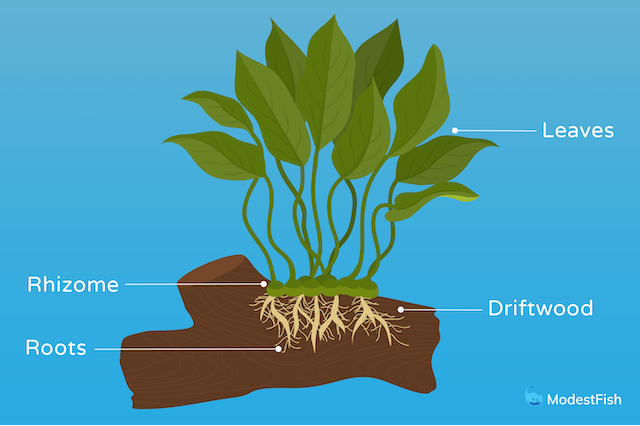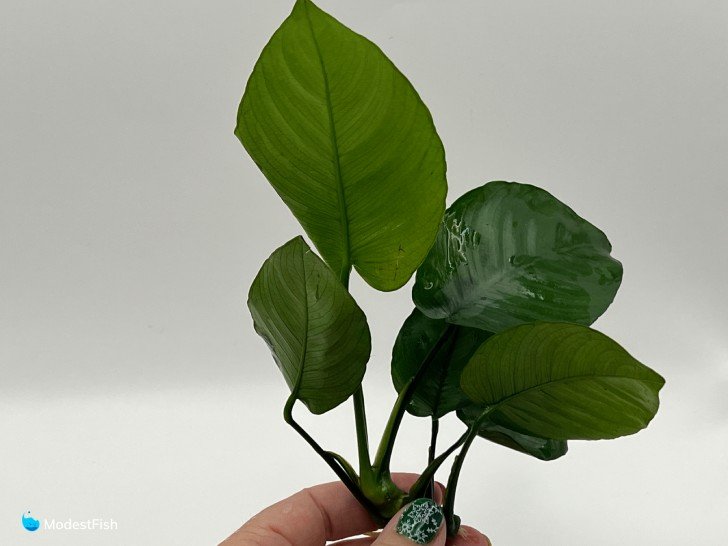A genus of aquatic and semi-aquatic plants native to tropical central and western Africa, I highly recommend anubias to beginner and seasoned aquarists.
They’re so easy to take care of and I have always really liked how they look in my aquariums.
In this guide, I teach you everything you need to know to have thriving anubias in your tank.
Table of Contents
Anubias Plants Origins
Right off the bat, I think I should explain that the common name “anubias” refers to an entire genus of plants, not just one particular species.
On top of that, there are also several cultivars and varieties of the most common species, Anubias barteri. Other’s include:
- Anubias Barteri var. Nana
- Anubias Barteri var. Nana Petite
- Anubias Barteri “Coffeefolia”
- Anubias Congensis
- Anubias Hastifolia
So, lots and lots of different plants, but they’re all sold under the same common name.
This genus of plants is native to freshwater rivers and streams throughout tropical regions in Africa.
Anubias attaches itself to surfaces like sunken logs, roots or rocks along the riverbank.

It can grow either emersed (with the leaves above the water line) or immersed (completely underwater).
But its roots and rhizome need to stay underwater or the plant will dry out and die.
Anubias Anatomy

Anubias plants grow from a central rhizome. It’s like a thick stem that grows horizontally (for the most part) instead of vertically.
Roots grow from the bottom of the rhizome and leaves emerge from the top.
Like many water plants, anubias plants mainly feed directly from the water column. Their roots mostly function to anchor the plant.

Scientific Classification
- Kingdom: Plantae
- Clade: Tracheophytes
- Clade: Angiosperms
- Clade: Monocots
- Order: Alismatales
- Family: Araceae
- Subfamily: Aroideae
- Tribe: Anubiadeae
- Genus: Anubias
Caring For Anubias Plants In Your Aquarium

Let’s discuss how you can care for anubias in your planted tank.
Growth Rate
Anubias is fairly slow growing. Depending on conditions, it might only put out one new leaf every 1-4 weeks!
Placement
This depends on the size of your tank and the species of anubias you choose.
Something small, like A. nana, could be a foreground plant tank in a large tank, like a 40 gallon (151 liter). Or a mid or background plant in a nano tank.
Since there are so many species and varieties of anubias, it’s important to try to research the species so you know how big it will be once it matures.
But luckily, if your anubias eventually grows too large, you can easily move it to another location in the tank.
Lighting
One of the greatest things about anubias is that it prefers low lighting. So there’s no need to invest in super expensive LED lights for this plant.
It will thrive even under small LEDs for something like a Betta tank.
Pro Tip: If you have high light conditions in your tank, it’s best to plant your anubias in a shaded area to help control algae growth.
Substrate
Anubias feeds mostly from the water column, so there’s no need for expensive aquasoil.
You can grow anubias in the substrate by burying the roots and leaving the rhizome unburied.
The rhizome will usually rot, killing the plant, if it is buried.
But, rather than try to bury the roots in the substrate, I personally have had the best luck by attaching my anubias to rocks and driftwood.
I usually attach it with a drop of Crazy Glue initially. As the plant continues to grow, the new roots it puts out will adhere to the surface of the driftwood.
Pro Tip: You can use any brand of glue to attach plants like anubias and Java fern as long as it is 100% cyanoacrylate.
CO2 and Fertilizers
You absolutely do not need to add CO2 to your tank to grow these plants. Of course, it will make it grow more quickly, but it is not required.
I’ve seen this plant thrive in a jar placed on the sill of a sunny window. It’s not picky at all.
I do recommend adding a liquid micronutrient fertilizer to your water.
I’ve used Seachem Flourish on mine for years and have had great results. You really only need to dose once a week to see results.
Pro Tip: Anubias feed directly from the water column, so no need to use any kind of root tab fertilizers.

Last update on 2024-04-22 / Commissions Earned / Images from Amazon Product Advertising API
Anubias For Algae Control
Algae loves anubias, and I mean it really loves it.
All the different species of algae want to retire from their busy careers growing on tank walls so they can live the good life on some anubias leaves.
OK maybe it’s not quite that bad, but seriously, those broad leaves make it a frequent target of nuisance algaes.
To help prevent algae from growing on your anubias:
- Plant it in a shaded area
- Put your lights on a timer to reduce the photoperiod
- Keep up with water changes to reduce nutrients in the water
The best way to fight algae on anubias leaves is to spot treat it with Seachem Flourish Excel (not Flourish Comprehensive!).
I use a dosing syringe with a blunt tip needle so that I can apply the Excel directly onto the algae. The syringes are supposed to be single use, but for this application, you can use the same one over and over.
After a few days, the algae will die off, you may notice it turn white or even red, depending on the species.
Pro Tip: For best results, be sure to turn off your filter and air pump while dosing Excel so that there is no water movement. This stops the Excel from being immediately washed off the plants. If possible, keep the water movement to a minimum for 20 minutes to give the Excel time to kill the algae.


Last update on 2024-04-22 / Commissions Earned / Images from Amazon Product Advertising API
How to Plant Anubias In Your Tank

Planting anubias is also really simple. I’ll go over three different methods for you.
Using Super Glue
This is my preferred method. You can use any brand of “Super Glue” as long as it is 100% cyanoacrylate.
You don’t have to worry about getting everything dry. Cyanoacrylate will set up even if it’s underwater.
All you need is a small dot of super glue on the rock or driftwood that you’re attaching the anubias to. Then press the rhizome onto the glue and hold it until the glue sets, usually in a few seconds.
As the plant grows, its new roots will adhere to the rock or driftwood over time.
Using Fishing Line
I’ve used this method, but it can be a bit more of a pain, in my opinion.
You just tie the anubias to whatever you’re attaching it to. Make sure to tie the plant very gently, just enough to get it to stay in place. If you tie the fishing line too tightly, it can cut into the rhizome of the plant.
Of course, this can be easier said than done. It works great if you have a convenient branch of driftwood, but many rocks and large pieces of driftwood can make this more difficult.
Just like with super glue, as new roots form, they’ll adhere to whatever the anubias is tied to. Once the plant has a good grip, you can snip off the fishing line and discard it.
In the Substrate
This is my least favorite method because you do risk the rhizome rotting if this isn’t done correctly.
The easiest way to do this is to lightly bury the roots and rhizome in the substrate. Then, very gently pull up on the rhizome until it is above the substrate, leaving the roots buried in the substrate.
The roots will stick to the substrate as the plant grows. You just have to be very, very careful to make sure that the rhizome is completely unburied or it may rot over time, killing the plant.
How to Propagate Anubias
Propagating anubias is actually super easy! All you have to do is cut the rhizome. I usually just snip it with a sharp pair of scissors.
It’s best to cut off a piece that has several leaves attached to it. The old plant will start putting off new growth and the cutting will as well.
Common Anubias Varieties
Anubias Barteri

Max height: 12 inches (30 centimeters)
This is the most common species of anubias. It has broad, pointed leaves. It makes a great mid or background plant in smaller tanks.
Anubias Barteri var. Nana

Max height: 5 inches (13 centimeters)
This variety of anubias is a dwarf variety. I highly recommend this as a foreground or midground plant for smaller tanks.
Anubias Barteri var. Nana Petite
Max height: 5 inches (13 centimeters)
This variety can reach the same size as other A. Nana, but it grows more leaves than other varieties and the leaves are much smaller.

Last update on 2024-04-22 / Commissions Earned / Images from Amazon Product Advertising API
Anubias Barteri “Coffeefolia”
Max height: 6 inches (15 centimeters)
This interesting cultivar has ruffled leaves that can be bright green or even coffee brown. At 6 inches tall, this is a good mid or background plant.
Anubias Congensis

Max height: 8 inches (20 centimeters)
This species has sharply pointed, bright green leaves. It gets fairly tall and makes a good background plant in smaller tanks.
Anubias Hastifolia
Max height: 16 inches (41 centimeters)
This species grows much longer stems than other species and is therefore much taller than most anubias. It grows fewer leaves than other varieties and makes a great background plant.
Is an Anubias Plant Right for You?
I highly recommend this genus of plants to just about any aquarist.
They’re so easy to take care of and I have always really liked how they look.
Another selling point: most herbivorous fish don’t like the taste of the leaves. So this is an excellent choice if you have herbivorous fish that tend to munch on plants.
The leaves are also very tough, so it’s not easy for fish to bite off mouthfuls.
I’ve only had one fish go after anubias, a particularly homicidal green severum. But frankly, she would viciously destroy any plant you put in the tank.
Other than the severum, all my other herbivorous fish simply ignored the anubias in favor of tastier, more tender plants.
I can’t guarantee that fish like African cichlids or goldfish won’t try to eat anubias, but it’s your best bet to keep plants in a tank with destructive fish.
And, if you attach it to large rocks or driftwood, it won’t be ripped up by fish that like to dig.
I hope you find this information helpful.
I wish you and your fish (and plants!) the very best!
